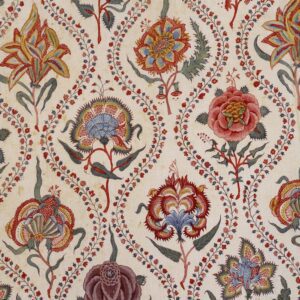
Block printing and a short story
If we search through the manuals of dyes and printing in the past centuries, the most interesting thing that could be found is the reference to using natural dyes in calico printing. Calico is a simple name for many different techniques that involve the application of patterned mordants and dyes with the use of wooden carved blocks, or with pencils, or screens, Calico printed textiles are called chintz.
The English were much enchanted by the colourful block prints they encountered in India when they first set up their trading posts for the East India Company in Surat (1619), Madras (1639), Bombay (1668), and Calcutta (1690). The cheap finely woven cottons were swiftly imported to England together with silk piece goods, indigo, saltpetre and spices from South India. There they found much favour as a cheerful alternative for the heavy wools and stiff linens of the time.

The ruling fashion of puffy wide dresses with a narrow bodice helped the prints come out in their best and for the working class it soon became extremely popular. The fabrics were so cheap and widely available that even common people could afford them, which certainly was not the case with the richly embroidered fashion that came before. By 1700 the value of chintz (the name for calico printed textiles) import overtook the total value of the spice trade.
Soon it became strictly forbidden to bring in printed goods from India, but the possibility of importing raw cotton and printing it in England was still open. The traditional block printing technique was way too slow and labour intensive to be cost-effective and this lead to a period of fast innovation. Screen printing, printing machines with huge cylinders and special steam houses made calico a local industry that was thriving. Chintzes remained the hype of the time until the sleeker, more flowing dresses that came into fashion, demanded a different type of textile. Even so, calico printing was still (and is still) popular in home decor and as such the industry remained, albeit on a smaller scale.
